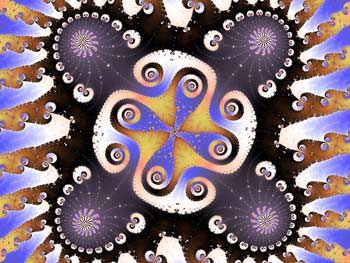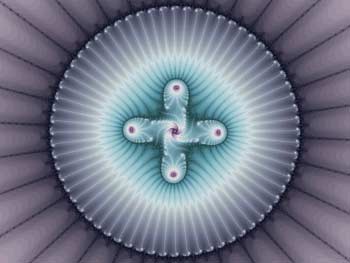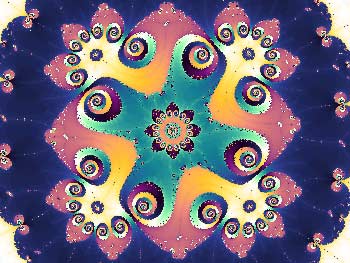The Mandelbrot SetExploring Infinity
And now, at last, we begin our exploration of one of the most amazing objects in all of mathematics - the famed Mandelbrot Set. Let us discover the infinite beauty... of algebra!
Click mouse to Zoom In <Ctrl>-Click mouse to Zoom Out Add <Shift> to Zoom faster
Play with the fractal above for a while. Explore the details on the edge. You can find (literally) countless examples of Self-Similar patterns within the Mandelbrot Set.
But interestingly, unlike the simple IFS fractals from the previous chapter, which show the same kind of detail everywhere, at all scales, the Mandelbrot Set is NOT perfectly self-similar.
The styles of the objects from different parts of this fractal are dramatically different. Furthermore, the patterns can actually GAIN in complexity and beauty the deeper you explore.
One of the most spectacular discoveries in the Mandelbrot Set is that as you zoom into it, you can find an infinite number of tiny copies of the entire object.
And every one of these replicas is just as complicated as the original, and you could explore the details around the edge of a replica as well. And then of course, you can
find even smaller replicas, around the replicas, and so on. <Ctrl>-click to zoom out of the replicas above to discover where in the main Mandelbrot Set they come from.
Amazingly, while there is an infinite diversity of shapes and patterns in the Mandelbrot Set, the rules that govern the way the shapes
behave are universal. We will explore some of the structural rules that operate within this fractal, which will shed light on the complex
behavior of simple equations. You will also be able to predict what shapes you will find in different areas, and how they connect, branch, twist and interact,
allowing you to discover virtually any fractal pattern you can imagine.
Handling the ScaleThe four images above are all inconceivably tiny details from different areas deep within the Mandelbrot Set, and are far smaller than anything in the real universe. (And they are all connected!) To manage the sizes of these mathematical objects, we must use Exponential Notation, which allows us to easily manipulate gigantic and miniscule numbers. A reasonable estimate for the size of the universe is 100 billion light years, or roughly 1027 meters. At the other end of the range, the smallest theoretical scale - known as the Planck LengthREF -
is approximately 10-35 meters. To find the difference in scale, we simply subract the exponents: 27 - (-35) = 62 orders of magnitude! This is the entire range of scale from the smallest to the largest in our universe. |
||||||||
|
<- PREVIOUS NEXT -> © Fractal Foundation. |
||||||||



